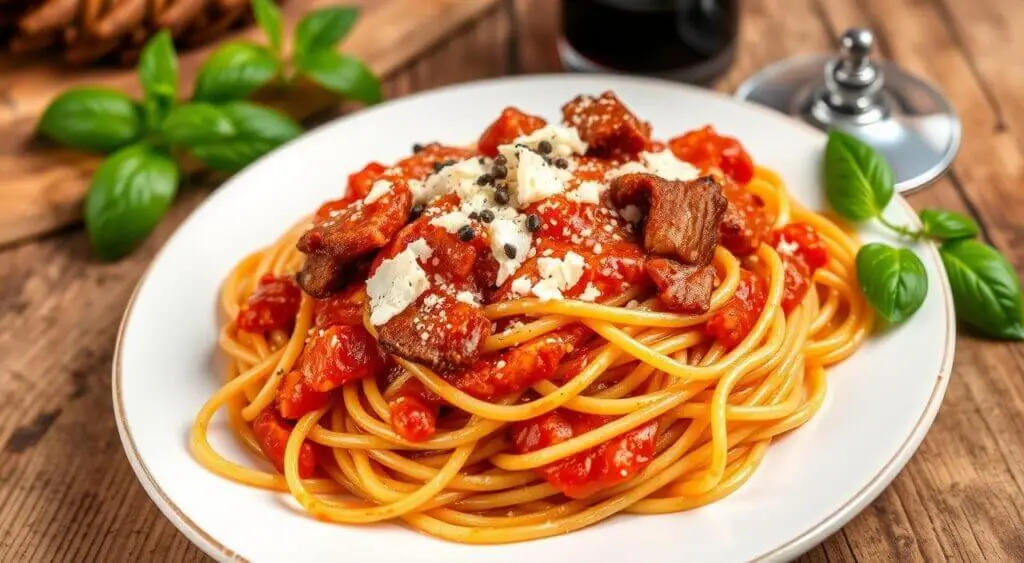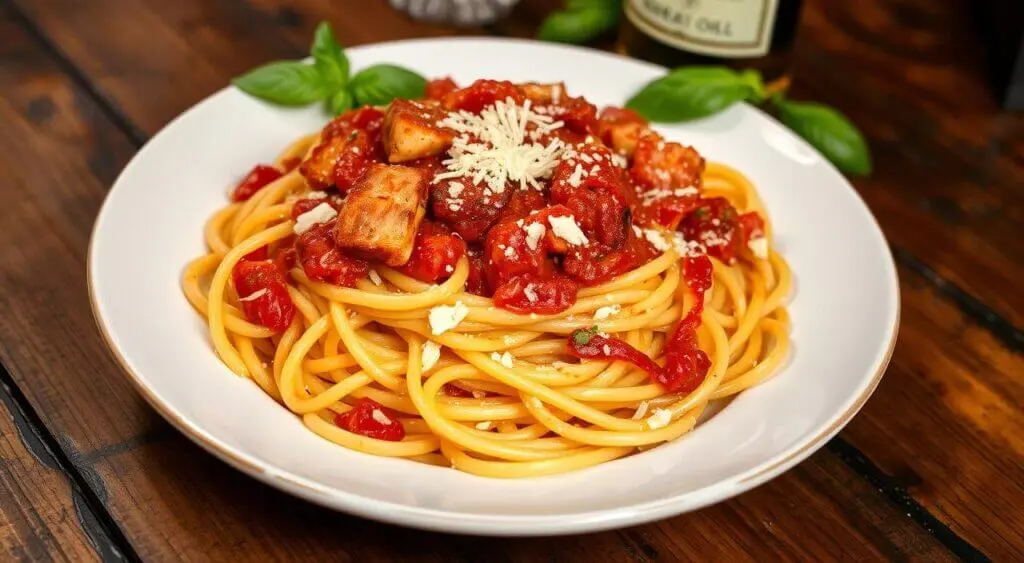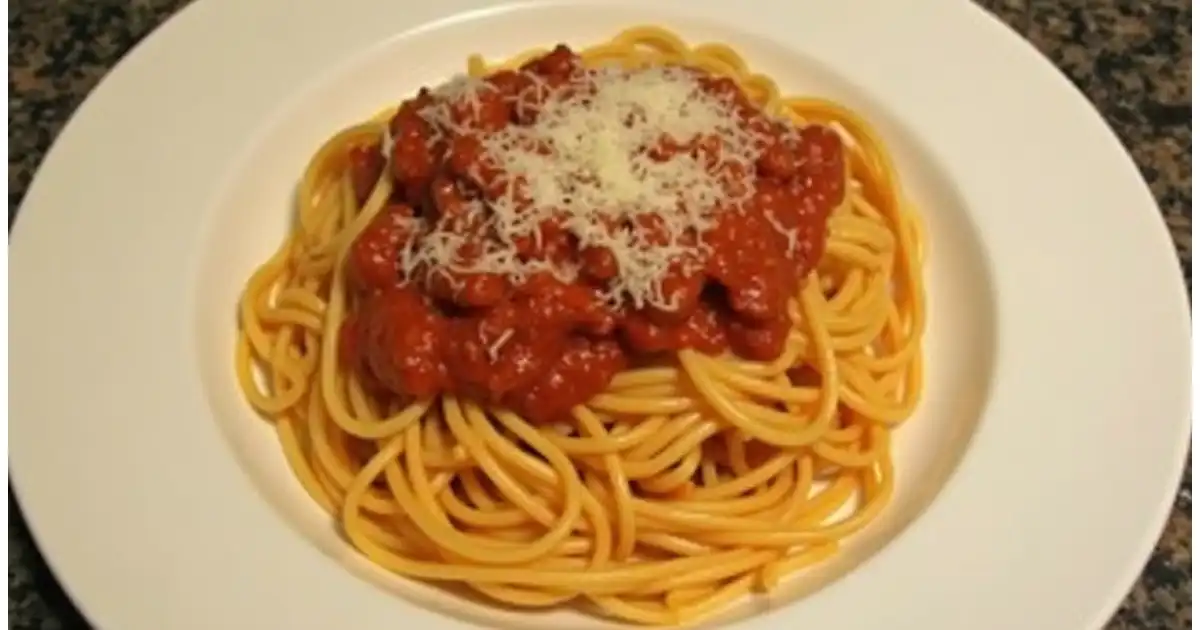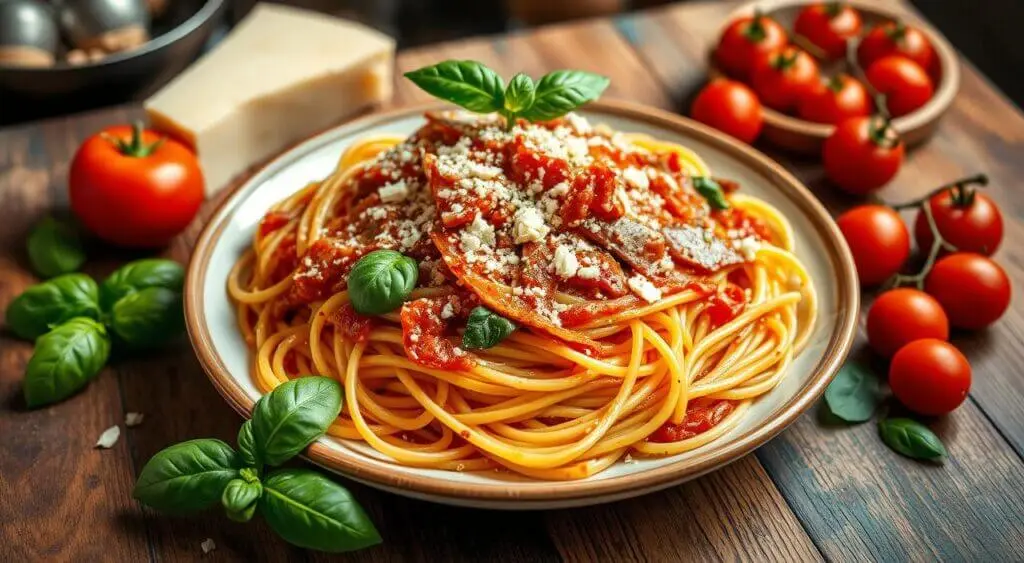Table of Contents
Pasta all’Amatriciana is a classic Roman dish that captures the heart of Italian comfort food. This authentic pasta amatriciana recipe highlights the rich flavors and simple ingredients. These elements come together to create a satisfying and memorable meal.

The secret to a delicious pasta all’Amatriciana is using high-quality ingredients. It also requires taking the time to prepare each component with care. From the savory guanciale to the tangy Pecorino Romano cheese and the sweet San Marzano tomatoes, every element is crucial.
Whether you’re a seasoned home cook or new to Italian cuisine, this pasta amatriciana recipe will become a favorite. Get ready to enjoy the bold tastes of Rome in your own kitchen!
Key Takeaways
- Pasta all’Amatriciana is a beloved Roman pasta dish with a rich history
- Authentic ingredients like guanciale, Pecorino Romano, and San Marzano tomatoes are essential
- The dish is easy to prepare at home with a few simple steps
- Variations and adaptations cater to different dietary needs and preferences
- Pairing the pasta with the right wine enhances the dining experience
Introduction to Pasta all’Amatriciana
Pasta all’Amatriciana is a beloved Italian dish loved by many. It’s a classic pasta amatriciana recipe that balances flavors perfectly. Each ingredient is key to a memorable meal.
The main parts of a true amatriciana pasta sauce recipe are:
- Guanciale: A cured pork cheek that adds a rich, savory flavor to the sauce
- Pecorino Romano cheese: A tangy, salty cheese that complements the sweetness of the tomatoes
- San Marzano tomatoes: A variety of plum tomatoes known for their sweet, intense flavor and low acidity
The dish comes from Amatrice in the Lazio region of Italy. It has grown in popularity across the country. Now, it’s a key part of Italian cuisine.
“Pasta all’Amatriciana is a testament to the simplicity and elegance of Italian cooking. With just a handful of high-quality ingredients, you can create a dish that is both comforting and luxurious.”
When making Pasta all’Amatriciana, using the best pasta amatriciana ingredients is crucial. Here’s a comparison of traditional and substitute ingredients:
| Traditional Ingredient | Readily Available Substitute |
|---|---|
| Guanciale | Pancetta or Bacon |
| Pecorino Romano | Parmigiano-Reggiano |
| San Marzano Tomatoes | High-Quality Canned Plum Tomatoes |
While substitutes may not taste exactly like the traditional ingredients, they can still make a tasty amatriciana pasta sauce recipe.
The History and Origin of Amatriciana Pasta
The amatriciana pasta history starts in Amatrice, a small town in central Italy. This town in the Lazio region is where this famous dish was born. It has won the hearts of pasta fans everywhere.
The Humble Beginnings in Amatrice
The story of pasta all’amatriciana begins with Amatrice’s shepherds. They worked hard in the mountains, carrying simple foods like guanciale, pecorino cheese, and pasta. These ingredients helped them make a tasty dish that would become known as pasta all’amatriciana.
“Pasta all’amatriciana is a dish that embodies the spirit and traditions of Amatrice. It’s a testament to the ingenuity and resourcefulness of our ancestors.” – Giovanni Santini, local historian
Evolution of the Dish Over Time
As pasta all’amatriciana became more popular, the recipe changed. The original, called pasta alla gricia, didn’t have tomatoes. It wasn’t until the late 19th century that tomatoes were added, bringing color and a tangy taste.
| Time Period | Key Changes in Amatriciana Pasta |
|---|---|
| Early 19th century | Original version (pasta alla gricia) without tomatoes |
| Late 19th century | Introduction of tomatoes to the recipe |
| 20th century | Popularization of the dish in Rome and beyond |
| 21st century | Global recognition as a classic Italian pasta dish |
As it grew in popularity, pasta all’amatriciana reached Rome. It became a favorite in the city’s eateries. Now, it’s loved by people all over the world, each bite a piece of Italian history.
Key Ingredients for Authentic Pasta all’Amatriciana
To make a real pasta all’amatriciana, you need the right ingredients. Each one is important for the dish’s rich taste. Let’s look at the main ingredients that make this Italian dish so loved.
Guanciale: The Star of the Show
Guanciale, a cured pork jowl from Italy, is the main ingredient. It has a rich, salty taste and soft texture. When it cooks, it melts, adding a tasty fat to the sauce.
“Guanciale is the essence of amatriciana. Without it, the dish simply isn’t the same.”
Pecorino Romano: The Perfect Cheese Pairing
Pasta all’amatriciana needs Pecorino Romano cheese. This sharp, salty cheese comes from Rome’s areas. It pairs well with guanciale and tomatoes, adding depth to the dish.
Choose a high-quality, aged Pecorino Romano. It should be firm, crumbly, and slightly granular.
San Marzano Tomatoes: The Ideal Base
San Marzano tomatoes are grown near Mount Vesuvius. They have a sweet, intense flavor and low acidity. These tomatoes are key for a great amatriciana sauce.
When buying San Marzano tomatoes, look for the “Pomodoro San Marzano dell’Agro Sarnese-Nocerino D.O.P.” mark. This ensures you get the real San Marzano tomatoes.
Using guanciale, Pecorino Romano cheese, and San Marzano tomatoes will help you make a pasta all’amatriciana that would impress any Italian nonna.
Step-by-Step Guide to Making Pasta all’Amatriciana
Making pasta amatriciana at home is simpler than you think. With a few steps and quality ingredients, you can enjoy this classic Italian dish. Here’s how to make pasta all’amatriciana:
- Start by cutting the guanciale into small cubes, about 1/4 inch thick. Heat a large skillet over medium heat and cook the guanciale until crispy and golden, stirring occasionally. This should take about 5-7 minutes.
- While the guanciale is cooking, bring a large pot of salted water to a boil. Cook the pasta according to the package instructions until al dente.
- Once the guanciale is crispy, add the minced garlic and red pepper flakes to the skillet. Sauté for about 30 seconds, until fragrant.
- Pour in the crushed San Marzano tomatoes and stir to combine. Simmer the sauce for 8-10 minutes, allowing the flavors to meld together.
- When the pasta is cooked, reserve 1/2 cup of the pasta water before draining. Add the cooked pasta to the skillet with the sauce and toss to coat evenly. If needed, add some of the reserved pasta water to loosen the sauce and create a silky texture.
- Remove the skillet from the heat and stir in the grated Pecorino Romano cheese. Taste and adjust the seasoning with salt and black pepper as needed.

To serve, divide the pasta all’amatriciana among individual bowls. Garnish with additional Pecorino Romano cheese and freshly ground black pepper. For a perfect pairing, consider serving this dish with a glass of robust red wine, such as Montepulciano d’Abruzzo or Chianti.
“The key to a great pasta amatriciana is using high-quality ingredients and letting the flavors shine through.”
By following this guide, you’ll make a restaurant-quality pasta amatriciana at home. Remember, the key to success is using the best ingredients and letting the flavors develop. With practice, you’ll master making this beloved Italian dish.
Variations and Adaptations of the Classic Recipe
The traditional pasta all’Amatriciana recipe is indeed tasty. But, sometimes you might need to change it to fit your diet. Whether you’re vegetarian, vegan, or need gluten-free options, you can still enjoy its rich flavors.
Vegetarian and Vegan Options
For a vegetarian pasta Amatriciana, just skip the guanciale. Use smoked tofu, tempeh, or mushrooms instead. They give a similar savory taste to guanciale. Here are some choices:
- Smoked tofu cubes, sautéed until crispy
- Tempeh bacon, crumbled and browned
- Shiitake mushrooms, sliced and sautéed with garlic and olive oil
For a vegan version, swap Pecorino Romano cheese with a vegan option. Many vegan cheeses now taste like Pecorino Romano. Some brands include:
| Brand | Product |
|---|---|
| Violife | Just Like Parmesan Block |
| Follow Your Heart | Dairy-Free Parmesan Alternative |
| Go Veggie | Vegan Parmesan Grated Topping |
Gluten-Free Pasta Alternatives
Gluten-free diets don’t mean missing out on Amatriciana sauce. Pair it with gluten-free pasta. Look for pasta made from chickpea, lentil, quinoa, or brown rice.
- Chickpea pasta
- Lentil pasta
- Quinoa pasta
- Brown rice pasta
When cooking gluten-free amatriciana pasta, follow the package instructions. Cooking times might differ from wheat pasta. Also, be careful of cross-contamination risks in shared kitchens.
“Pasta all’Amatriciana is a dish for everyone, no matter your diet. With a few tweaks, you can make a tasty meal that honors this classic Italian recipe.”
Pairing Pasta all’Amatriciana with Wine
Choosing the right wine for wine pairing with pasta amatriciana can make your meal unforgettable. This classic Italian dish has bold flavors. It needs a wine that can match its intensity and enhance its taste.
For the best wine for amatriciana pasta, a strong Italian red is perfect. The sauce’s tangy tomatoes, spicy chili, and salty guanciale pair well with certain wines:
- Montepulciano d’Abruzzo: This red wine has the right balance of acidity and tannins. It’s great with the tomato sauce.
- Chianti Classico: From Tuscany, this wine has vibrant acidity and flavors that match the guanciale and cheese.
- Primitivo: This red from Puglia has ripe fruit and spice. It’s strong enough for the Amatriciana sauce.

If you like white wine, choose a crisp, medium-bodied one. A Pinot Grigio or Verdicchio can offer a refreshing contrast to the pasta’s rich flavors.
| Wine | Characteristics | Pairing Notes |
|---|---|---|
| Montepulciano d’Abruzzo | Medium-bodied, balanced acidity and tannins | Complements the tomato-based sauce |
| Chianti Classico | Vibrant acidity, savory undertones | Pairs well with guanciale and Pecorino Romano |
| Primitivo | Full-bodied, ripe fruit flavors, hint of spice | Stands up to the bold taste of Amatriciana sauce |
“A good wine is like a good meal; it should be shared with friends and family, savored slowly, and remembered long after the last drop is gone.”
The secret to a great wine pairing with pasta amatriciana is to pick a wine that brings out the dish’s flavors. By choosing one of the suggested red or white wines, you’ll enjoy a memorable Italian meal.
Pasta Amatriciana: A Favorite in Italian Restaurants
Pasta all’Amatriciana is loved worldwide in Italian restaurants. It wins hearts with its bold flavors and simple charm. If you’re looking for a comforting pasta dish, try the best Amatriciana restaurants.
Top Restaurants Known for Their Amatriciana
Many famous Italian places are proud of their Amatriciana. Here are some top spots known for their amazing Amatriciana:
| Restaurant | Location | Specialty |
|---|---|---|
| Roscioli | Rome, Italy | Traditional Amatriciana with homemade pasta |
| Felice a Testaccio | Rome, Italy | Generous portions and a lively atmosphere |
| Osteria da Fortunata | Rome, Italy | Handmade pasta and a cozy, rustic setting |
At these places or any Italian restaurant, you’ll find Amatriciana. It’s a favorite in Italy, loved by both locals and visitors.
Tips for Ordering Pasta all’Amatriciana When Dining Out
For a real Amatriciana experience, remember these tips:
- Choose restaurants known for Roman or Lazio cuisine, where Amatriciana comes from.
- Ask if the pasta is homemade, as fresh pasta makes a big difference.
- Find out about the guanciale in the sauce. Good guanciale is key for authentic Amatriciana.
- Pair your pasta with a local red wine like Cesanese or Montepulciano d’Abruzzo. It enhances the flavors.
By following these tips and finding top Amatriciana restaurants, you’ll have a memorable meal. It’s a celebration of this iconic Italian dish.
Nutritional Value and Health Benefits of Amatriciana Pasta
Indulging in pasta all’amatriciana might surprise you with its nutritional value and health benefits. This classic Italian dish is more than just a tasty meal. It’s packed with good stuff for your body.
Pasta amatriciana’s nutrition is quite interesting. It has carbs, proteins, and fats in a balanced way. The pasta gives you complex carbs for energy. The guanciale adds protein and healthy fats.

The sauce’s star, San Marzano tomatoes, are full of lycopene. This antioxidant fights off diseases and keeps your heart healthy. Tomatoes also have vitamin C, boosting your immune system and skin.
Pecorino romano cheese is another key ingredient. It’s not just for flavor; it’s also full of calcium for strong bones. Plus, it has good bacteria for your gut.
Remember, pasta amatriciana is best enjoyed in moderation. Its calorie count depends on how much you eat and any extra toppings.
Indulging in a plate of pasta all’amatriciana can be a delightful way to savor Italian cuisine while reaping some potential health benefits.
So, when you enjoy pasta amatriciana, you’re not just pleasing your taste buds. You’re also feeding your body with important nutrients and health-boosting ingredients.
Frequently Asked Questions About Pasta all’Amatriciana
Are you excited to make pasta all’Amatriciana? You might have some questions. Here are answers to common questions about this classic Italian dish. They’ll help you make an authentic and tasty meal.
Can I Use Pancetta Instead of Guanciale?
While guanciale is the traditional choice, pancetta is a good substitute. Guanciale comes from pork jowl, and pancetta from pork belly. Both are cured meats, but guanciale tastes richer and more intense. If you can’t find guanciale, pancetta will still make a tasty sauce, but it will taste slightly different.
Is Pasta all’Amatriciana Spicy?
Traditionally, pasta all’Amatriciana has a bit of heat from red pepper flakes. But, you can adjust the spice to your liking. If you like it spicier, add more red pepper flakes. For a milder taste, use less or none at all.
Can I Make Amatriciana Sauce Ahead of Time?
Yes, you can make the Amatriciana sauce ahead of time. This is great for dinner parties or busy weeknights. Just make the sauce, let it cool, and store it in an airtight container in the fridge for up to 3 days. Reheat it in a pan and toss with fresh pasta when you’re ready to serve.
Here’s a quick comparison of making the sauce ahead of time versus preparing it fresh:
| Make-Ahead Sauce | Fresh Sauce |
|---|---|
| Convenient for busy schedules | Best flavor and texture |
| Allows flavors to meld | Requires more time before serving |
| Can be stored for up to 3 days | Served immediately after cooking |
Whether you make the sauce ahead of time or fresh, you’ll enjoy the rich flavors of pasta all’Amatriciana. Knowing these common questions will help you create a delicious meal that will impress everyone.
Serving Suggestions and Garnishing Ideas
When serving pasta amatriciana, a few garnishes can make it look great. Sprinkle Pecorino Romano cheese on top for extra flavor and texture. Add some chopped parsley or basil leaves for color and freshness.
Pair your pasta with garlic bread or a green salad for a complete meal. The bread is great for soaking up sauce. The salad adds a refreshing touch to the rich pasta.
For a rustic look, serve the pasta in warmed bowls or on large plates. This lets the sauce spread out and show its color. A drizzle of extra virgin olive oil before serving adds to the aroma and taste.
FAQ
Can I use pancetta instead of guanciale in pasta all’Amatriciana?
Pancetta can be a good substitute for guanciale, but it changes the flavor. Guanciale, from cured pork cheeks, gives a richer taste. If you can’t find guanciale, pancetta is a good choice, but it won’t be the same.
Is pasta all’Amatriciana spicy?
Pasta all’Amatriciana has a bit of spice from red pepper flakes or chili peppers. You can adjust the spice to your liking. For less heat, use less red pepper flakes or skip them.
Can I make Amatriciana sauce ahead of time?
Yes, you can make Amatriciana sauce ahead and keep it in the fridge for up to 3 days. It’s great for meal prep. Just reheat it and cook the pasta for a quick, tasty meal.
Are there any vegetarian or vegan alternatives for pasta all’Amatriciana?
You can make pasta all’Amatriciana without guanciale for vegetarian or vegan diets. Use vegan bacon or smoky mushrooms instead. Vegan Parmesan cheese can replace Pecorino Romano. It’s a tasty, different version of the dish.
What type of wine pairs well with pasta all’Amatriciana?
Medium to full-bodied red wines go well with pasta all’Amatriciana. Chianti Classico, Montepulciano d’Abruzzo, and Primitivo are great choices. For white wine, try Verdicchio or Pecorino for a full-bodied taste.
1 thought on “Pasta all’Amatriciana: 5 Amaze-Worthy Secrets You Need to Know”